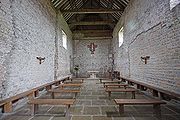
St Peter-on-the-Wall
Encyclopedia

Bradwell-on-Sea
Bradwell-on-Sea is a village in Essex, England. The village is on the Dengie peninsula. It is located about north-northeast of Southminster and is east from the county town of Chelmsford. The village is in the District of Maldon in the parliamentary constituency of Maldon whose boundaries were...
, Essex
Essex
Essex is a ceremonial and non-metropolitan county in the East region of England, and one of the home counties. It is located to the northeast of Greater London. It borders with Cambridgeshire and Suffolk to the north, Hertfordshire to the west, Kent to the South and London to the south west...
is a Grade I listed building and among the oldest largely intact Christian
Christianity
Christianity is a monotheistic religion based on the life and teachings of Jesus as presented in canonical gospels and other New Testament writings...
church buildings in England still in regular use, dating from the 7th century. It is at the eastern end of the St Peter's Way long distance footpath from Chipping Ongar
Chipping Ongar
Chipping Ongar is a small market town, and a civil parish called Ongar, in the Epping Forest district of the county of Essex, England. It is located East of Epping, South-East of Harlow and North-West of Brentwood.-Geography:...
to this church.
Dark Ages

Bede
Bede , also referred to as Saint Bede or the Venerable Bede , was a monk at the Northumbrian monastery of Saint Peter at Monkwearmouth, today part of Sunderland, England, and of its companion monastery, Saint Paul's, in modern Jarrow , both in the Kingdom of Northumbria...
, Historia Ecclesiastica 3.22), originally constructed as an Anglo-Celtic Church for the East Saxons in AD 654 by St Cedd, astride the ruins of the abandoned Roman
Ancient Rome
Ancient Rome was a thriving civilization that grew on the Italian Peninsula as early as the 8th century BC. Located along the Mediterranean Sea and centered on the city of Rome, it expanded to one of the largest empires in the ancient world....
fort of Othona
Othona
Othona or Othonae was the name of an ancient Roman fort of the Saxon Shore at the location of the modern village Bradwell-on-Sea in Essex, England...
. The current structure was most likely built around 660-662, incorporating the Roman bricks and stones. Cedd travelled south from Lindisfarne
Lindisfarne
Lindisfarne is a tidal island off the north-east coast of England. It is also known as Holy Island and constitutes a civil parish in Northumberland...
to spread Christianity at the behest of Sigeberht the Good, then King of the East Saxons, in 653 and returned the next year having been ordained as a Bishop in order to build this Chapel and probably others too. Following the death of St Cedd in October 664 from plague, the Chapel became part of the Diocese of London.
Middle Ages
No further record exists of the Chapel's use until 1442 when the local clergy reported to the Bishop of London that it had been expanded slightly, with a small tower above the porch with a bell in it. However, they did not know of its origins and it was unusable, having been burnt. It was repaired and returned to regular use alongside the parish church in Bradwell-on-Sea until at least the Tudor period (16th century) before falling into disuse as a church again and being used as a barn--the position of the wide barn doorway, now filled in, can be seen on the south side of the nave.Modern times
In 1920 it was restored and reconsecrated as a chapel. It is a Grade I listed building.The Othona
Othona
Othona or Othonae was the name of an ancient Roman fort of the Saxon Shore at the location of the modern village Bradwell-on-Sea in Essex, England...
Community
Community
The term community has two distinct meanings:*a group of interacting people, possibly living in close proximity, and often refers to a group that shares some common values, and is attributed with social cohesion within a shared geographical location, generally in social units larger than a household...
, located five minutes walk away, generally uses the Chapel twice a day for its short, informal acts of worship. Founded in 1946 by Norman Motley, this Christian-based community is open to people of all faiths and none.
St Peter-on-the-Wall in fiction
- The novel The Nearest FarAway Place by Ray Crowther (ISBN 0-9541110-0-1) has several scenes based at the Chapel.
External links
- Official website for the Chapel of St Peter-on-the-Wall
- The Othona Community
- St Peter's Chapel, Bradwell-on-sea, Unlocking Essex's Past, Essex County Council

